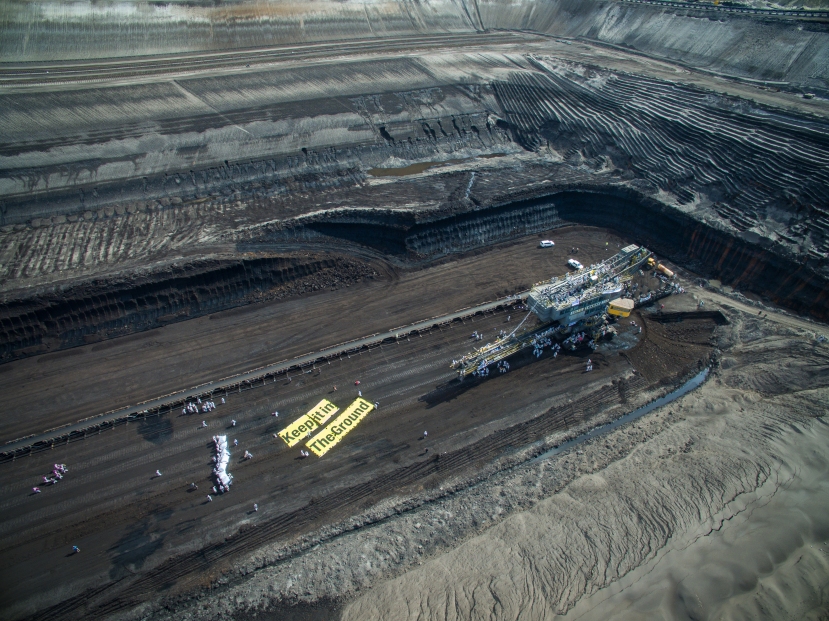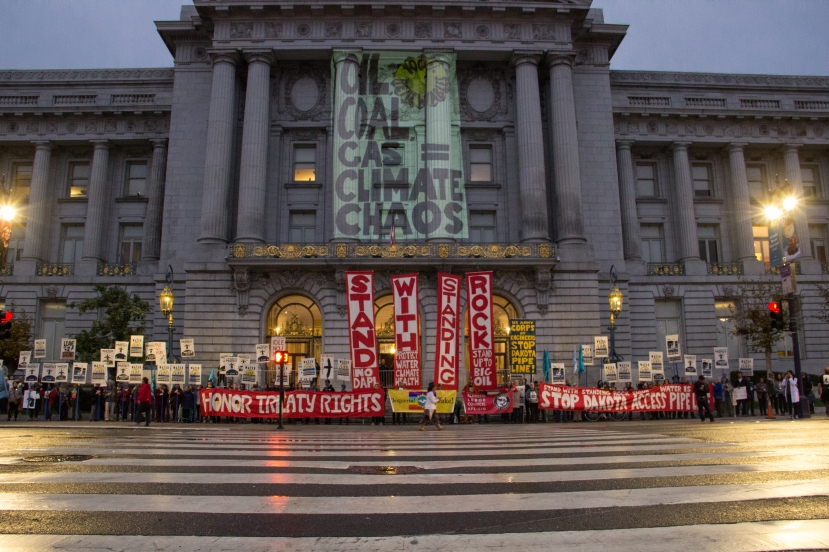
Climate activists in the Lusatia coal fields of Germany shut down one of Europe’s largest open cast coal mines in May 2016 as part of the Ende Gelände campaign. Photo credit: Ende Gelände/350.org via Flickr.
Arctic sea ice continued to melt, forests were felled and coral died en masse, in 2016 there were ominous predictions surrounding the longevity of summertime polar ice caps and greenwashing merely persisted as a thing. Even the most earnest of environmentalists must be, by now, completely desensitised to last year’s string of broken/records, and has since returned to twitter to vent on #ExxonKnew.
Trump, his cabinet picks, and Brexit were of little comfort and succeeded only in perpetuating uncertainties surrounding U.S. and UK environmental ambitions and the dour narrative of the climate debate in general. Yet whilst western establishments adjusted to new status quos, atmospheric carbon failed in all 12 months of last year to drop below 400 parts per million, encroached on an already dwindling carbon budget and helped average global temperatures surpass 1.5 ℃ above pre-industrial levels in February and March.
So where are the success stories? The pick-me-ups to be taken from what is at first glance, a truly awful year for environmental news.
Despair less – inside and out of political and economic circles 2016 showed that policy, grassroots and technological responses can coax an increasingly inclusive environmental movement forward when faced with big, petite-handed hurdles that you seem to think you’ve met before.
A report released in March by the UN Environment Programme showed record increases of renewable capacity during 2015, especially in developing countries and documented a 5% increase in renewable energy investment globally, doubling those of fossil fuels suffering from dwindling oil and gas prices. The International Energy Association (IEA) confirmed that carbon emissions had been decoupled from economic growth (for a second year running), consolidating renewables as a mainstream energy source able to compete with fossil fuels in business as usual markets, replace coal and help stall global emissions. The reports followed falling costs in renewable power production and preceded increased solar and wind capacity across the globe.
Morocco completed the first phase of its concentrated solar plant, Noor 1, producing 160 megawatts (MW) of solar thermal energy consumed by over 650,000 citizens. On completion, the solar plant will be the largest of its kind, produce 500 MW of power and reduce the country’s carbon emissions by 560,000 tonnes – launching it towards majority renewable electricity by 2030. On wind, Britain gave planning consent to expand the Hornsea One offshore wind project, led by Danish company Dong Energy, with an extra 1.8 Gigawatts (GW) of electricity being provided by 300 wind turbines. Alone, Hornsea One will be the largest offshore wind farm in the world and when combined with Hornsea Two (which may not be the last) the farms will provide close to 1.6 million U.K homes with low carbon electricity and have an output similar to that of Hinkley Point C at a fraction of the cost. Across the Atlantic, Rhode Island may have finally rid the US of its aversion to offshore wind. The 30 MW Block Island Wind Farm is home to the first five offshore US turbines and went online in December last year. Admittedly it’s tiny, but the project is primarily a pilot to show that there aren’t any eco-anarchists hiding out in turbine masts, or whatever. Importantly it is the first offshore development in the US to maintain public and media support for long enough to allow completion – think Cape Wind amongst many others that didn’t – and with 11 commercial leases available for offshore projects in the US with a potential 14.6 GW to offer the energy mix, like all good pilots maybe it’s the start of something more lasting. In 2016 the World Economic Forum got the thoughts of 750 leading economists who came to the conclusion that climate disasters are the new greatest threat to the global economy. Although irritating as it may be that their assertions will likely result in more action on climate change than years of activism and steady dissemination of knowledge, we can hope that any resulting government subsidies, investments in cleantech and installations can maintain the renewables boom.
Last years Medium-Term Coal Market Report, compiled by the IEA, stated that demand for the most polluting and archaic of fossil fuels will not increase over the next five years, and may signal the end for coal in developed nations, at least. China’s coal consumption has been the biggest barrier to global emissions reductions in this millennium, but for the third year running production has continued to decline, suggesting consumption may have peaked in the world’s largest greenhouse gas emitting nation. In the first half of 2016 worldwide coal developments shrunk by 14%, driven primarily by new policies in Asia. China announced that it planned to close 1,000 coal mines in a single year and though it fell well short of targets by mid-summer, oversupply issues can hope to stunt the sector’s growth over the next five years. Similarly, India’s underutilisation of existing coal-fired power stations led to the downsizing of plans for future infrastructure development. Private companies also felt the effect of demand downturns and in April the largest privately owned coal company, Peabody Energy Corp, filed for bankruptcy, which made it the fifth large coal mining company to do so in just 13 months. Grossly excessive spending on lobbying in the years running up to its insolvency made the event pretty enjoyable for those involved in the climate debate that thrive on Schadenfreude.
Across the globe it is clear governments are moving away from coal, the US-based Sierra Club’s Beyond Coal campaign ushered support for Obama’s Clean Power Plan which has led to significant drops in States’ consumption. Britain also announced it will close all coal power stations by 2025 following Europe-wide trends of reduced coal dependency – and although developing economies in Asia tend to absorb decreases in demand elsewhere, opposition is increasing in the continent, and the plight experienced by opposers deserves our solidarity.

Opinion polls highlight a void between Trump and his base vote on issues surrounding climate. Photo credit: Gage Skidmore via Flickr.
However inaccessible and niche the output of climate scientists may seem, they continued to write open letters and have your best interests in mind throughout last year. Possibly-cum-universally alarmed by the Trump administration’s appointment of Scott Pruitt, climate experts are putting fail-safes in place for the sake of humanity. The “guerilla archiving” of U.S. Environmental Protection Agency (EPA) climate data began in December, seeking to prevent the political manipulation of masses of crucial measurements by safeguarding them in databases. Civil servants and federal employees in the U.S. Energy Department have also been giving the President-elect’s transition teams a hard time by refusing to respond to a questionnaire, recovered by Bloomberg, requiring a list of staffers and contractors who have attended United Nations climate change meetings, fearing its use in post-inauguration ‘witch’ hunts. The backlash against the memo has since resulted in the Trump team “disavowing” the questionnaire stating it was not subject to standard protocols.
Statistics surrounding the treatment of environmental defenders and activists in 2015 were sinister at best and 2016 seemed no different. In the face of indifferent corporate conduct and aggressive policing, grassroots victories continue to prove the worth of organised movements helping to redress the persisting void between policy and public opinion.

Protesters in San Francisco opposing the Dakota Access Pipeline which poses a major threat to the Standing Rock Sioux and indigenous peoples water supply and to US emissions targets. Photo credit: Peg Hunter via Flickr.
Looking to 2017, a reactionary political landscape will demand that society takes the initiative on climate change and the only way for the layperson to do so is to engage in the debate. Whether this is achieved through a vote, consumer choice or affiliation with a movement – 2016 showed that actions like these can amount to greater change and that there is still the possibility of a low carbon version of society, it’s probably just waiting patiently for us at the end of some grotty tunnel.
Categories: climate change, energy, politics
Assess your notes to identify patterns and problems. After you have completed reading and taking notes on your textual content, glimpse over your notes to determine what patterns are existing from the textual content and what problems stand out to you. Try to identify a choice to one particular in the problems you have identified. For example, you may detect that Frankenstein’s monster is often even more likable than Doctor Frankenstein, and make an educated guess about why this is.
Your treatment to the problem should help you to definitely build a focus to your essay, but keep in mind that you choose to do not absolutely need to have a stable argument about your textual content at this point. As you continue on to think about the textual content, you will move closer to the focus including a thesis on your critical analysis essay. ]
Don’t: learn the author’s mind: Mary Shelley intended Frankenstein’s monster to be even more likable considering. Do: phrase it as your unique interpretation: Frankenstein’s monster is far more sympathetic than his creator, leading the reader to question who the true monster really is.
Part Two of Four: Conducting Research Edit https://payforessay_net/buy-essay
LikeLike